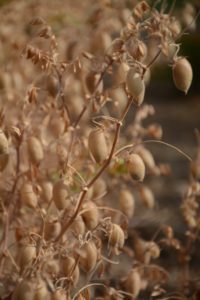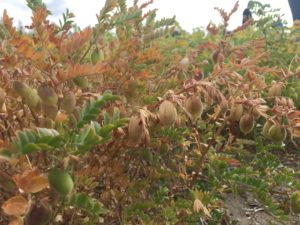Pre-Harvest Considerations
|
Crop Maturity
|
- Chickpeas are considered ready to harvest when the majority of the plants are yellow and most pods are mature. At this stage, the top of the plant may still be green.
- Chickpeas are very sensitive to late season frosts, and seeds can be adversely affected by as little as 2 to 3 degrees of frost during the pod filling and ripening stage.
- Time your chickpea harvest appropriately to ensure the highest possible yield.
- A decision to begin harvest will hinge on a majority of the field meeting certain criteria. Do not sacrifice the quantity and quality of your crop waiting for smaller greener areas to reach the proper stage to start harvest.
|
SEED MOISTURE CONTENT
|
- Chickpea combining can start when seed reaches about 18% moisture content.
- Chickpeas are considered dry and safe to store at <14%, chickpeas are considered to be tough at 14.1% - 16% seed moisture, and considered damp at >16.0%.
- As moisture levels decline, especially in kabuli chickpea types, seed begins to shrink from the seed coat and becomes more susceptible to damage in handling at less than 13%.
|
FIELD MONITORING
|
- Pre-harvest field monitoring will help determine which harvest system to consider, if more than one is available, and will greatly assist in determining when to begin harvest operations.
- Monitoring fields means checking plants in numerous locations for uniformity of stages of maturity.
- Most fields will not be 100% uniform in topography – there could be greener conditions in lower, wetter areas and further advanced plants on higher areas.
- Harvesting too early will result in immature seeds – this is especially important as immature chickpea seeds will result in downgrading.
- Harvesting too late when the pods are dry and brittle may result in shatter losses and will increase the risk of poorer quality seed due to adverse weather.
- The decision to start the harvest process will depend on three factors:
- crop maturity (stage of uniformity – how variable is the crop’s maturity?)
- seed moisture content
- presence of weed growth.
- Other considerations may include weather patterns, and marketing considerations (for human consumption, livestock feed or seed).
|
PRESENCE OF WEED CONTROL
|
- Waiting for green weed growth to drydown will jeopardize quality and yields.
- Swathed green weeds are unlikely to dry sufficiently in a few days, so combining will be delayed.
- Green weed material in a straight-cut operation will cause extra wetness in the threshing areas of the combine, resulting in moisture on the seed coat and dirt adhering to this moisture (earth tag). Grades will be lowered because of earth tag (see below).
|
PRE-HARVEST AIDS (GLYPHOSATE)
|
- Various chemical harvest management tools are available to aid in the preparation for combining. It’s important to select the right product for the right crop and the intended outcome.
- Crop desiccation and dry down and pre-harvest perennial weed products are not the same. Make sure to select the right product, follow label directions, and timing of application. Harvest aid products vary in speed of activity, efficacy, and pre-harvest intervals.
- Apply glyphosate, a systemic herbicide, for pre-harvest weed control but not for desiccation. See Desiccation information further below.
- Pre-harvest glyphosate should be applied when the crop has 30% or less chickpea seed moisture. At this stage, chickpea stems are green to brown in colour, pods are mature (yellow to brown in colour) and 80% to 90% leaf drop (original leaves) has occurred.
- This treatment will provide perennial weed control, and can also be used to stop late season chickpea re-growth, and some drydown. However, drydown may be inconsistent and is unlikely to occur under cool, wet conditions.
- Glyphosate, a systemic herbicide, will kill and drydown all green growth in approximately 14 to 21 days and will allow for a straight cut operation or swathing and combining immediately.
- The crop and in-crop weeds must have enough green material remaining at application time for the herbicide to be effective.
- Do not apply glyphosate products to any crops that will be harvested for seed as this causes irregular germination and seedling development can occur.
- Applying glyphosate too early can reduce yield and seed size, and late-season applications may result in levels of glyphosate in the seed that exceed maximum allowable levels.
- Growers must take appropriate risk mitigation steps to ensure product residues remain below maximum residue limits (MRLs) set by regulatory agencies. See Keep it Clean below.
- Prior to applying glyphosate, check with potential buyers. Some companies are NOT accepting peas where glyphosate was used pre-harvest as weed control.
|
KEEP IT CLEAN
|
- Certain crop protection products can restrict the marketing options for your pulse crop. Before you make your crop management plans, talk to your grain buyer and read the Keep it Clean Pulse Maximum Residue Limits Advisory for a list of products of concern this year, and the steps you can take to mitigate risk.
- More than 85% of Canada’s pulse production is exported to feed the world. Market access is important to the Canadian pulse industry, and growers play a key role in keeping the doors open.
- Source: For the latest Keep it Clean updates, visit Keep it Clean.
|
GRADING CONSIDERATIONS
|
- Chickpea size and colour is very important for quality.
- The stage of the crop should be closely monitored, as harvesting too early increases the chance of green seed in the crop, which lowers the grade and value of the grain.
- Deductions are implemented if immature green seeds comprise more than 0.5% in kabuli, and 1% in desi chickpeas.
- Early frost, as little as 2°C or 3°C, during pod filling and ripening can result in immature green seed in the harvested crop, significantly reducing the grade and value.
- Other factors that negatively affect seed quality are Botrytis or Sclerotinia in the seed, admixtures, small seed size, and a lack of seed uniformity.
|



